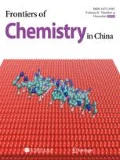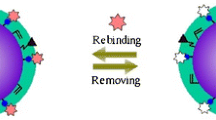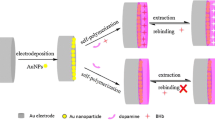Abstract
Molecularly imprinted polymers (MIPs), based on photografting surface-modified polystyrene beads as matrices, were prepared with acrylamide as the functional monomer, bovine hemoglobin as the template molecule and N, N′-methylene bisacrylamide as the crosslinker in a phosphate buffer. The results of IR, scanning electron microscope (SEM) and elemental analyses demonstrated the formation of a grafting polymer layer on the polystyrene-bead surface. Subsequent removal of the template left behind cavities on the surface of the polymer matrix with a shape and an arrangement of functional groups having complementary binding sites with the original template molecule. The adsorption studies showed that the imprinted polymers have a good adsorption capacity and specific recognition for bovine hemoglobin as the template molecule. Our results demonstrated that the polymer prepared via the photografting surface-modified method exhibited better selectivity for the template. Attempts to employ the new method in molecular imprinting techniques may introduce new applications for MIPs and facilitate probable protein separation and purification.
Similar content being viewed by others
References
Wulff G. Molecular imprinting in cross-linked materials with the aid of molecular templates—a way towards artificial antibodies. Angew Chem Int Ed Engl, 1995, 34: 1812–1832
Mosbach K. Molecular imprinting. Trends Biochem Sci, 1994, 19: 9–14
Haupt K, Mosbach K. Molecularly imprinted polymers and their use biomimetic sensors. Chem Rev, 2000, 100: 2495–2504
Hu S G, Li L, He X W. Comparison of trimethoprim molecularly imprinted polymers in bulk and in sphere as the sorbent for solid-phase extraction and extraction of trimethoprim from human urine and pharmaceutical tablet and their determination by high-performance liquid chromatography. Anal Chim Acta, 2005, 537: 215–222
Hu S G, Li L, He X W. Solid-phase extraction of esculetin from the ash bark of Chinese traditional medicine by using molecularly imprinted polymers. J Chromatogr A, 2005, 1062: 31–37
Guo H S, He X W, Li Y J. Imprinted polymeric film-based sensor for the detection of dopamine using cyclic voltammetry. Chinese J of Chem, 2003, 21: 1624–1629
Rong F, Feng X G, Li P, Yuan C W, Fu D G. Preparation of imprinted polymer microbeads using iniferter photografting surface-modified method Chinese science Bulletin, 2006, 51(13): 1504–1508
Anderson L, Sellergren B, Mosbach K. Imprinting of amino acid derivatives in macroporous polymers. Tetrahedron Lett, 1984, 25: 5211–5214
Yoshida M, Hatate Y, Uezu K, Goto M, Furusaki S. Chiral-recognition polymer prepared by surface molecular imprinting technique. Colloids Surfaces A, 2000, 169: 259–269
Vlatakis G, Andersson L I, Mosbach K. Drug assay using atibody mimics made by molecular imprinting. Nature, 1993, 361: 645–647
Quaglia M, Chenon K, Hall A J. Target analogue imprinted polymers with affinity for folic acid and related compounds. J Am Chem Soc, 2001, 123: 2146–2154
Fisher L, Muller R, Ekberg B. Direct enantioseparationary phase prepared by molecular imprinting. J Am Chem Soc, 1991, 113: 9358–9360
Burow M, Minoura N. Molecular imprinting: synthesis of polymer particles with antibody-like binding characteristics for glucose oxidase. Biochem Biophys Res Commun, 1986, 227: 419–422
Shi H, Tsai W B, Garrison M D, Ferrari S, Ratner B D. Template-imprinted nanostructured surfaces for protein recognition. Nature, 1999, 398: 593–597
Yang H H, Zhang S Q, Yang W, Chen X L, Zhuang Z X, Xu J G, Wang X R. Molecularly imprinted sol-gel nanotubes membrane for biochemical Separations. J Am Chem Soc, 2004, 126: 4054–4055
Pang X S, Cheng G X, Lu S L, Tang E J. Synthesis of poly-acrylamide gel beads with electrostaticfunctional groups for the molecular imprinting of bovine serum albumin. Anal Bioanal Chem, 2006, 384: 225–230
Mi H F, Guo M J, Zhao Z, Fan Y G, Wang C H, Shi L Q, Xia J J, Long Y. Protein-imprinted polymer with immobilized assistant recognition polymer chains. Biomaterials, 2006, 27: 4381–4387
Lin T Y, Hu C H, Chou T C. Determination of albumin concentration by MIP-QCM sensor. Biosensors and Bioelectronics, 2004, 20: 75–81
Bossi A, Bonini F, Turner A P F, Piletsky S A. Molecularly imprinted polymers for the recognition of proteins: The state of the art. Biosensors and Bioelectronics, 2007, 22: 1131–1137
Venton D L, Gudipati E. Influence of protein on polysiloxane polymer formation—Evidence for induction of complementary protein-polymer interactions. Biochim Biophys Acta, 1995, 1250: 126–136
Rachkov A, Minoura N. Towards molecularly imprinted polymers selective to peptides and proteins. The epitope approach. Biochim Biophys Acta, 2001, 1544: 255–266
Kempe M, Mosbach K. Separation of amino acids, peptides and proteins on molecularly imprinted stationary phases. J Chromatogr A, 1995, 691: 317–323
Nicholls I A, Rosengren J P. Bioseparation, 2002, 10: 301–305
Zhang W Y, Li X, Zhu L L. Advances in preparation of surface molecularly imprinted materials. Modern Chemical Industry, 2005, 12: 20–23
Qin S H, Qiu K Y. Living radical polymerization and copolymerization of vinyl monomers initiated with novel iniferters. Acta Polymerica Sinica, 2002, 2: 127–136
Chen, Wang G J. Preparation of block and graft copolymer with iniferters. Polymer Bulletin, 2003, 4: 79–84
Tamayo F G, Titirici M M, Esteban A M. Synthesis and evaluation of new propazine-imprinted polymer formats for use as stationary phases in liquid chromatography. Anal Chim Acta, 2005, 542: 38–46
Rukert B, Hall A, Sellergren B. Molecularly imprinted composite materials via iniferter-modified supports. J Mater Chem, 2002, 12: 2275–2280
Pang X S, Cheng G X, Li R S, Lu S L, Zhang Y H. Bovine serum albumin-imprinted polyacrylamide gel beads prepared via inverse-phase seed suspension polymerization. Anal Chim Acta, 2005, 550: 13–17
Guo T Y, Xia Y Q, Hao G J, Song M D, Zhang B H. Adsorptive separation of hemoglobin by molecularly imprinted chitosan beads. Biomaterials, 2004, 25: 5905–5912
Author information
Authors and Affiliations
Corresponding author
Additional information
__________
Translated from Chemical Journal of Chinese Universities, 2008, 29(1): 64–70
About this article
Cite this article
Gai, Q., Liu, Q., Li, W. et al. Preparation of bovine hemoglobin-imprinted polymer beads via the photografting surface-modified method. Front. Chem. China 3, 370–377 (2008). https://doi.org/10.1007/s11458-008-0089-x
Published:
Issue Date:
DOI: https://doi.org/10.1007/s11458-008-0089-x




